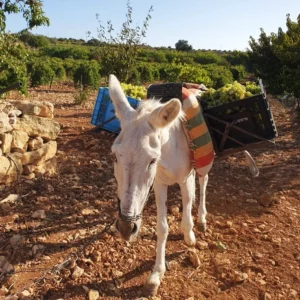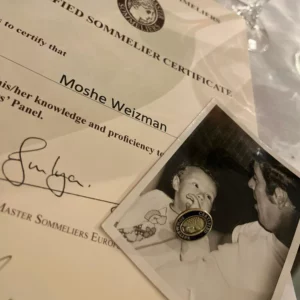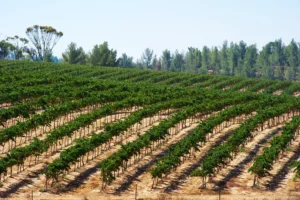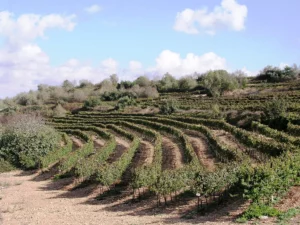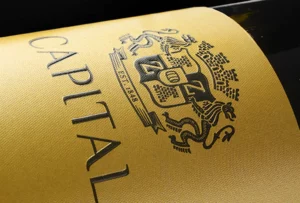The Middle East & Eastern Mediterranean was the cradle of the world’s wine culture, and Canaan must have been one of the earliest countries to enjoy wine, over 2,000 years before the vine reached Europe. The oldest grape pips found in the regions of modern Turkey, Syria and Lebanon date back to the Stone Age period (c. 8000 B.C.E.).
Noah Plants Vineyard
The art of winemaking is thought to have begun in the area between the Black Sea, the Caspian Sea and the Sea of Galilee. Indeed, the oldest pips of ‘cultivated’ vines, dating to c. 6000 B.C.E., were found in Georgia. The biblical Noah was the first recorded viticulturist who, after the flood, “became a husbandman and planted a vineyard.” As The Book of Genesis relates, he was also the first person to suffer from drinking too much!
The vine then traveled south, through Phoenicia and Canaan to Egypt, the world’s first great wine culture. It is known that the Egyptians particularly prized the wine of Canaan.
Moses’ Cluster of Grapes
In the Book of Numbers, the story is told of how Moses sent spies to check out the Promised Land. They returned with a cluster so large, that it had to be suspended from a pole and carried by two men. Today both Carmel Winery and the Israel Government Tourist Office use this image as their logo. The grapes were chosen to symbolize how the land flowed with milk and honey. The vine was one of the blessings of the Promised Land promised to the children of Israel.
In recent years excavations have uncovered ancient presses and storage vessels that indicate a well-developed and successful wine industry existed in the area. Grapes, grape clusters and vines were frequent motifs on coins and jars found from ancient times. Coins have been found commemorating the victories of the Hasmoneans and Bar Kochba with grapes featured as a symbol of the fertility of the country. Many wine presses and storage cisterns have been found from Mount Hermon to the Negev.
Inscriptions and seals of wine jars illustrate that wine was a commercial commodity being shipped in goatskin or pottery from ports such as Dor, Ashkelon and Joppa (Jaffa). The vineyards of Galilee and Judea were mentioned. Wines with names like Sharon, Carmel and from places like Gaza, Ashkelon and Lod were famous. The earliest storage vessels originated in southern Canaan and were known as Canaanite Jars. Today they are better known by their Greek name, ‘Amphora.’
King David’s Cellar
The Kings of Judah were said to have owned vast vineyards and stores for wine. King David’s wine holdings were so substantial that his court included two special officials to manage them. One was in charge of the vineyards and the other in charge of the cellars. This may have been Israel’s first sommelier!
At this time the Jewish devotion to wine was clearly shown in their developing literature, lifestyle and religious ritual. Indeed, anyone planting a new vineyard was exempt from military service, even in national emergency.
In about 1800 B.C.E. there was a communication which reported that Palestine was “blessed with figs and with vineyards producing wine in greater quantity than water.”
The Book of Isaiah gives very clear instructions of how to plant care for a vineyard, even to the point of suggesting the wine press is close to the vineyard.
Micha’s vision of peace on earth and harmony among men was illustrated with, “and every man will sit under his vine and under his fig tree and none shall make him afraid.”
The wine produced was not just for drinking but also important for medical purposes, for cleaning out homes and dyeing cloth. It was also used as a currency for paying tribute.
Winemaking in Ancient Israel and was at its peak during the period of the Second Temple. It was a major export and the economic mainstay of the era. However, when the Romans destroyed the Temple, Jews were dispersed and the once proud industry forsaken. The Arab conquest from 600 C.E. and Mohammed’s prohibition of alcohol caused many remaining vineyards to be uprooted,
The Crusades
The Crusaders briefly revived the cultivation of grapes in the Holy Land and grapes were planted in places like Bethlehem and Nazareth. The revival was short lived, but the Crusaders did return to Europe with many noble grape varieties which had their origins in the Middle East. Varieties such as Chardonnay, Muscat and Shiraz are said to come from the region.
On the founding of the Ottoman Empire, the Middle Eastern wine industry was finally obliterated because of the decline in wealth of the whole region and the wars and epidemics which greatly reduced and weakened the populations. Communities which had supported the wine industry finally departed. Prices of wine rose, consumption fell. Hashish, and later coffee, replaced wine as affordable intoxicants.
By Adam Montefiore. He works for Carmel Winery and regularly writes about wine in both Israeli and international publications.




